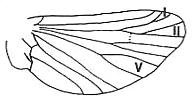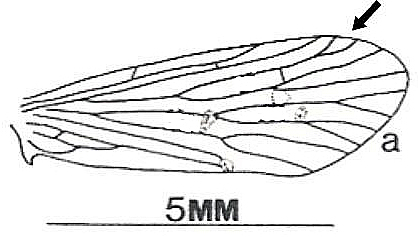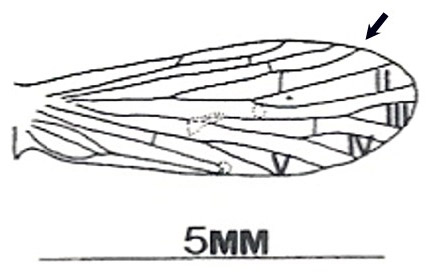 Aquatic Insects of Michigan
Aquatic Insects of Michigan
by Ethan Bright, Museum of Zoology Insect Division and School of Natural Resources and Environment
University of Michigan
- Home
- Species Lists
- Coleoptera
- Diptera
- Ephemeroptera
- Acanthametropodidae
- Ameletidae
- Ametropodidae
- Arthropleidae
- Baetidae
- Baetiscidae
- Behningiidae
- Caenidae
- Ephemerellidae
- Ephemeridae
- Heptageniidae
- Isonychiidae
- Leptohyphidae
- Leptophlebiidae
- Metretopodidae
- Neoephemeridae
- Oligoneuriidae
- Palingeniidae
- Polymitarcyidae
- Potamanthidae
- Pseudironidae
- Siphlonuridae
- Heteroptera
- Hymenoptera
- Lepidoptera
- Megaloptera
- Neuroptera (Sisyridae)
- Odonata
- Orthoptera
- Plecoptera
- Trichoptera
- Other Orders
- Keys/Identification
- Aquatic Insects of Michigan
Polycentropodidae (Tube-Making and Trumpet-Net Making Caddisflies) of Michigan - Identification
Introduction
Note that Phylocentropus is now included under the family Dipseudopsidae. Figures from Nimmo (1986), used by permission of the author.
Adults
(adapted from Nimmo 1986 and Schmid 1998)
| 1a | Spurs 2,4,4 | Cerotina Ross |
| 1b | Spurs 3,4,4 | 2 |
| 2a(1b) | Hindwing F-III present (Fig. 1) | Neureclipsis McLachlan |
| 2b | Hindwing F-III absent (Fig. 2) | 3 |
Fig. 1  Fig. 2 Fig. 2  |
||
| 3a(2b) | Forewing with F-I present (Fig. 3), and absent or present in hindwing | Polycentropus Curtis |
| 3b | Both wings with F-I absent | 4 |
Fig.
3  Fig. 4 Fig. 4 |
||
| 4a(3b) | Segment 2 of maxillary palp 3x as long as segment 3 | Nyctiophylax Brauer |
| 4b | Segment 2 of maxillary palp slightly shorter than third | Cyrnellus fraternus Banks |
Larvae< (adapted from Wiggins 1996)
| 1a | a. Anal claw with several conspicuous pointed teeth arising from ventral, concave margin | Nyctiophylax Brauer |
| b. A short, stout setae arising on each side of the pronotum | ||
| 1b | a. Anal claw lacking conspicuous pointed teeth on ventral, concave margin, or a row with many tiny spines | 2 |
| b. Often without such a stout setae arising from the side of the pronotum | ||
| 2a(1b) | a. Basal segment of anal proleg approximately same length as distal segment, largely without setae | Neureclipsis McLachlan |
| b. Concave margin of anal claw with a tiny row of spines | ||
| 2b | a. Basal segment of anal proleg distinctly longer than distal segment, and bearing many setae | 3 |
| b.Concave margin of anal claw lacking tiny spines | ||
| 3a(2b) | a. Dorsal plate between claw and lateral sclerite of anal proleg with two dark bands separated mesally | Cyrnellus fraternus Banks |
| b. Meso- and metanotal sa1 (=setal area 1) setae approximately same length as longest sa2 setae | ||
| 3b | a. Dorsal plate bewteen claw and lateral sclerite of anal proleg with two dark bands fused mesally | 4 |
| b. Metanotal and usually mesonotal sa1 setae not more than 1/3x long as longest sa2 setae | ||
| [note: Wiggins (1996, p. 161) cautions that the lack of associated larvae with adults of known North American species reduces the certainty of couplet 4] | ||
| 4a(3b) | a. Foreleg tarsus elongate, about 2/3x length of foretibia, and anal claw curved approximately to 90° | Cerotina Ross |
| b. mature larval length not more than 8 mm | ||
| 4b | a. Foreleg tarsus short, about 1/2x length of foretibia, or foreleg tarsus elongate, about equal or slightly longer in length to foretibia, or anal claw not curved approximately as much as 90° | Polycentropus Curtis |
| b. Mature larval length more than 10 mm | ||
References
-
Nimmo, AP. 1986. The adult Polycentropodidae of Canada and adjacent United States. Quaestiones Entomologicae 22:143-252.
Schmid F. 1998. The Insects and Arachmids of Canada, Part 7: Genera of the Trichoptera of Canada and Adjoining or Adjacent United States. NRC Research Press, Ottawa, Canada. 319 pp.
Wiggins GB. 1996. Larvae of the North American caddisfly genera (Trichoptera). University of Toronto Press, Toronto, Ontario. 457 + xiii.
Page created: July 17, 2003; Last edited: November 08, 2013 (EB)